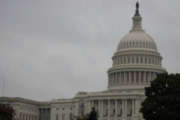The average American high school student probably doesn’t know who Bob Morse is, what he does or the outsize impact he has had on the lives of countless college-bound teenagers. On the flip side, Morse is a familiar figure to college and university leaders across the U.S., known for his work on the U.S. News Best Colleges rankings since 1987.
Morse joined U.S. News & World Report in 1976 as a member of the now-defunct economic unit. Morse, who remembers being the youngest member of his team then, conducted research that helped inform weekly features for the print magazine. In the years since, he experienced the company’s shift online and has helmed various rankings franchises for decades.
Morse recently marked his 45th anniversary with U.S. News and spoke about his time at the company and the evolution of the rankings. Questions and answers have been edited for length and clarity.
What was your plan as you prepared to enter college? Did you have a major in mind? A career path charted?
“Well, it was a long time ago. It was 1966 when I went to college. And the ’60s, that was the psychedelic generation: the Beatles, the Vietnam War, the protests. In terms of my personal journey, I went to the University of Cincinnati. I couldn’t get into the regular university, but they had a two-year college — which they don’t have now — on the same campus.
“If you went to this two-year program and took the same courses and got certain grades, you were guaranteed to get into the main University of Cincinnati, so that’s what I did. I transferred into the undergraduate business major, and that didn’t work. Then I moved into the liberal arts and got a bachelor’s degree in liberal arts and economics. But when I was in high school, I didn’t really have a specific career in mind. … It was more like just get a degree and see where it would lead.”
[See: 10 Things to Know About Selecting a College Major.]
What was U.S. News like 45 years ago? What do you remember about your first year?
“U.S. News, at the time, was employee-owned. The workforce tended to be older. There were international bureaus and domestic bureaus like a full news operation. There were photographers. It was a print product and everything was focused on the weekly magazine.
“There was a cafeteria, a company doctor and a nurse. It wasn’t similar to the current U.S. News, compared to that time, though there is a lineage of consumer-oriented journalism.”
How has U.S. News changed over 45 years? How has the media landscape itself changed?
“It was a print magazine; that was the product. It got mailed out and was on newsstands. There weren’t any rankings when I first started. We were competing with two other newsweeklies, Newsweek and Time. It was before the internet and cable TV.
“Now the whole media landscape with the internet, cable TV, newsletters and smaller publications — there’s way more coverage or access to information. The news cycle is much shorter than it was before; it’s almost hourly. Back then people were largely satisfied with weeklies and getting a digest of events a week later and some special features, but now that’s ended with the internet.
“But it’s also given our rankings a global reach, so we’re definitely reaching a larger audience.”
How did the U.S. News Best Colleges rankings come to be in 1983? What was the inspiration?
“I didn’t become involved in the rankings until 1987. I’m not 100% sure of the original idea, but I think it was part of consumer journalism. I think original surveys were done by the marketing department. It was a simple survey and simple methodology where college presidents chose their top 10 schools in their category. It was done as a feature in the weekly magazine.
“It wasn’t until 1987, after Mort (Zuckerman) bought the magazine, that the rankings expanded with the first guidebook. That took it to another level to create a different product outside the print magazine.”
How have the Best Colleges rankings evolved over the years?
“It’s evolved on a number of levels. We’ve changed the methodology. Now the outcomes are the primary weight in the rankings. We’re doing all of our own data collection. Social mobility, graduation rate performance, graduate indebtedness and class size are pretty common now, and they didn’t exist in the first rankings.
“The rankings have evolved to a considerable degree compared to how they originally were. And there are numerous other rankings.”
[Read: How U.S. News Calculated the 2021 Best Colleges Rankings.]
The rankings have drawn criticism over the years. How has U.S. News responded? And how do the rankings continue to evolve in response to those concerns or other unrelated factors?
“We haven’t ignored the criticism. As a tactic, or policy, or a way of doing business, we’ve tried to engage our critics, especially when they’re in higher education. We’ve tried to discuss why they don’t like what we’re doing and tried to engage them and have discussions with them. We’ve listened to the public discussions about what people care about in higher education.
“We’ve tried to incorporate data. When new information has become available, we really keep track of what’s being collected. We try to tell people that there’s not a perfect ranking and we’re not measuring all parts of a school. We try to emphasize that rankings should not be the sole tool to use when choosing a college and should be just one part of the information that a prospective student should use with their family to make a decision.”
How do you see the value of various U.S. News rankings? What is the benefit to consumers?
“I think the value is that we’re providing a way for parents and students to compare schools to each other with the most up-to-date data available. We’re also providing all of these other rankings … Most Innovative Schools, Best Undergraduate Teaching … We have a lot of ways of looking at various aspects of a school so that they’re not just focused on the school’s rank in the overall rankings. There’s a lot more information to look at. I think that’s a core benefit.”
[See: 10 Most Innovative National Universities.]
What do you foresee for the future of U.S. News rankings products?
“One of the biggest demands is for more rankings for individual majors or rankings for more fields, like we’ve done for undergraduate computer science.
“I’m sure there are areas of graduate school that we haven’t done. There are expansion possibilities for online rankings.”
Who is Bob Morse outside of the office? What are your passions and points of pride?
“Since I’ve been at U.S. News for 45 years, there is an assumption that I’m not young. I’m 73, I’m married and I have two grandchildren. I care about my family a lot.
“Some of my passions are exercising and hiking. In the pre-COVID-19 times, I was able to travel all around the world, go to conferences and speak about the rankings. I enjoyed that part of the job.”
How is working in a remote environment going for you?
“I think all of the time how lucky we are compared to the millions of people that have had their standard of living diminished; I guess ours has stayed about the same. It’s definitely isolating in the sense that I personally liked the human interaction. I’m an office person; I guess I had an office addiction.
“I’m looking forward to getting back to being around people more in the office environment, whether or not it’s the same, or how different it’ll be when we go back.”
Searching for a college? Get our complete rankings of Best Colleges.
More from U.S. News
Princeton, Williams Top 2021 U.S. News Best Colleges Rankings
Top 10 Historically Black Colleges and Universities
Discover the Top 20 Online Bachelor’s Programs
The Bob Morse Milestone: Celebrating 45 Years at U.S. News originally appeared on usnews.com







